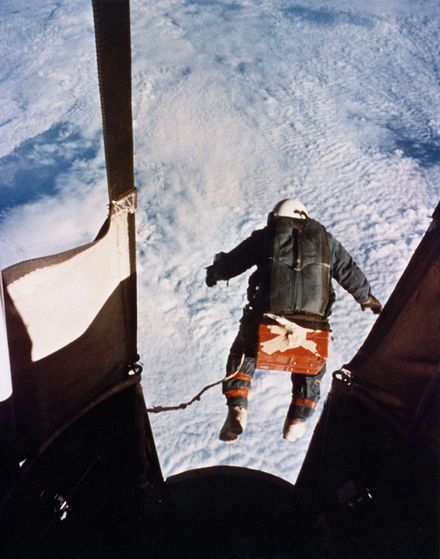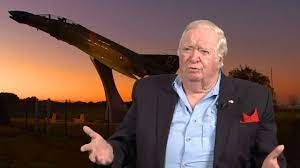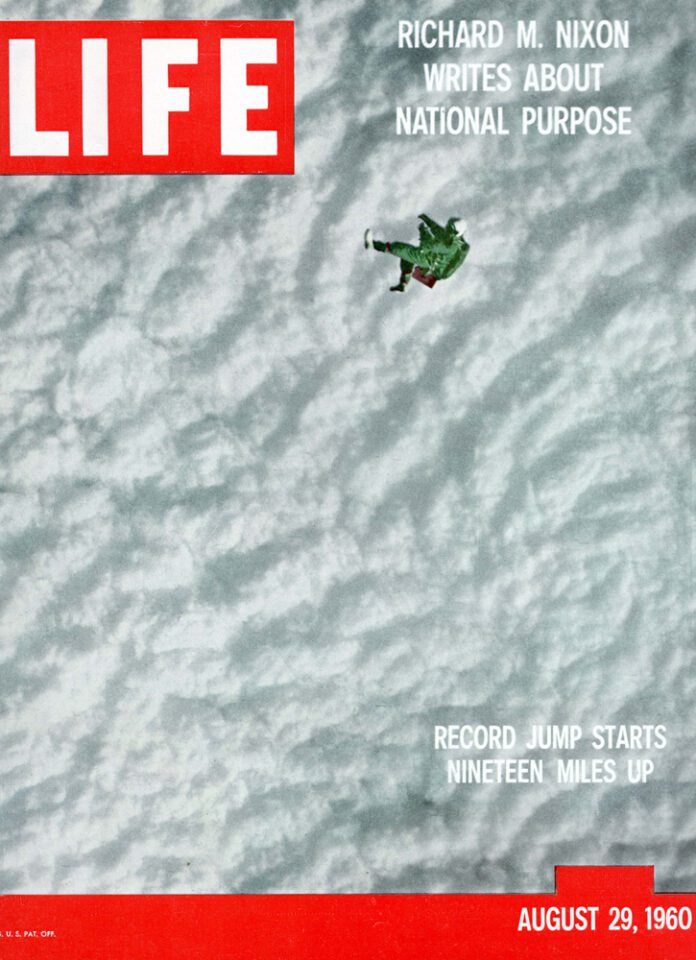Alan Shepard, the first American astronaut to fly in space, was once asked if he would have done a high-altitude parachute jump as part of his training. “That’s easy,” Shepard said. “Hell no. Absolutely not.” But one man, the estimable Joseph W. Kittinger, had no such reservations and made not just one, but three jumps from the stratosphere. It’s an overstatement to say the first manned spaceflights wouldn’t have happened without Kittinger’s supremely risky work. But his jumps helped NASA better understand the risks so it could shape ways to cope as it raced the Soviets into space during the 1960s.
Joseph Kittinger died this week at 94, after a varied career of the sort not many military officers lead. In later life, Kittinger wasn’t as celebrated among pilots as say, Chuck Yeager or Bob Hoover, but during the early 1960s, his exploits were well covered in the popular press. I’m sure most of us have seen the iconic photo of his gondola exit on the recording-setting Excelsior III jump in August 1960. Belly to earth, he’s framed inside the gate rails of the open gondola 80,000 feet above a broken overcast. Life Magazine published the photo that month, but it reserved another for the cover with Kittinger splayed out as he rolls on his back seconds after exiting. Somehow, I had never seen this photo until this week.
Kittinger was born in 1928 which, as with all the Mercury astronauts except John Glenn, made him too young to fly during World War II but positioned him perfectly to participate in the emerging space race during the late 1950s. (Deke Slayton also flew in World War II, but although he was selected for Mercury, he did not fly in the program.) Chuck Yeager once said that flight test had been an undesirable backwater assignment but that his historic Mach 1 flight in 1947 changed that. That might have inspired Kittinger to request Air Force work in the aerospace R&D segment. After his flight training and initial work in piston and early jet fighters, he was assigned to Holloman Air Force Base where he crossed paths with another aerospace giant, John Paul Stapp.

The timing was propitious. The very year he arrived, 1954, the Lockheed F-104 Starfigter had its first flight, demonstrating speed and altitude capabilities far beyond the F-84s and F-86s Kittinger had flown. Its performance also outstripped the Air Force’s understanding of the survival aspects of high-altitude ejections and high-G exposure. Stapp was interested in both and initiated research with rocket-powered sleds, using himself as a test subject and creating more indelible imagery we all saw as kids.
Then, Oct. 4, 1957, happened. The Soviet Union launched Sputnik I, orbiting a tiny satellite. The country went a little nuts. The Reds were soon to be in a position to hurl nuclear bombs on the U.S. from outer space and what was the government going to do about it? One immediate thing was to establish NASA to take over the work of the former National Advisory Committee for Aeronautics. NASA’s brief was all things space, with manned spaceflight a high priority.
But Stapp, Kittinger and David Simons were already investigating such things with two shoestring projects—Air Force, not NACA—designed to explore the physiological challenges at the fringe of space. Project Manhigh began in 1955 during which Kittinger flew in a balloon to an altitude of 96,784 feet, although the gondola was pressurized and he landed it by valving helium. No jumps. That would come during Project Excelsior, which began in 1958 with Kittinger as the test director. He made three test jumps, culminating in his record leap on Aug.16, 1960, from 102,800 feet.
As Al Shepard, no stranger to the ragged edge himself, noted, these flights represented crazy risk. Budgets were miniscule and the programs tested the very limits of novel technology. On Kittinger’s Manhigh ascent, his VHF radio failed immediately and an incorrectly installed valve vented his oxygen supply overboard. Plenty went wrong on the Excelsior flights, too. On the first, his faceplate fogged up, obscuring his view of his instruments. He exceeded his planned exit altitude by three miles. When he finally tried to leave his seat for exit, he was stuck for several minutes before he could free himself. And when he finally did, his stabilizing drogue prematurely deployed, its bridle wrapping around his neck and causing a 120 RPM spin. He was lucky to have survived, saved by an automatic opening device on his main parachute. He G-locked during the spin and regained consciousness only after landing in the desert.
On his final Excelsior jump, the pressurization in his right glove failed, causing it to swell painfully. He kept it from ground controllers and completed the flight successfully. Gutsy as he was, Kittinger still knew real fear. In his well-documented book, The Pre-Astronauts, author Craig Ryan reported that during debriefing when Kittinger heard himself repeatedly say “thank you God, thank you God” on his note recorder while descending under canopy, he couldn’t recall saying it. He angrily declared, “That is the voice of a coward!”
I doubt if anyone else would have thought that. Writing for National Geographic after Excelsior ended, Kittinger saw more applications for high-altitude balloon flights. “If we could put an astronomer with a telescope in a gondola and take him aloft for an unimpeded view,” he wrote, “we would see the heavens with new eyes.” And indeed, two years later, Project Stargazer launched, a high-altitude balloon flight with Kittinger and an astronomer aboard. But it didn’t sustain for lack of funding. But Stargazer foretold the Hubble and Webb space telescopes and Kittinger lived to see both.

Given his chosen profession, that was hardly a sure thing. Following Excelsior, at the age of 37, Kittinger went back to operational flying. He served three tours in Vietnam, flying A-26s and eventually the F-4. He was shot down by a Mig 21 in 1972 just days before his last tour was to end. He spent 11 months as a prisoner of war in North Vietnam before being repatriated with other prisoners in 1973. He returned to operational flying and retired in 1978.
But he wasn’t done with balloons and records. In 1984, he completed the first solo crossing of the Atlantic in a gas balloon and was active in reestablishing the Gordon Bennett Cup balloon competition. Kittinger gave freely of his time to help other record attempts, including Red Bull’s Felix Baumgartner’s breaking of Kittingers own free-fall altitude record in 2012. He was well known in the skydiving community and occasionally appeared at events I attended. He was outgoing and a terrific public speaker, colorfully relating the legacy of his life and the period he was fortunate enough to have lived in.
And what was that legacy? Mercury astronaut Deke Slayton summed it up succinctly: “We knew damned little at that time. That was an ambitious thing he did, and it was a valuable thing for the space program because when we got into Gemini, we had ejection seats for the first time and a lot of the information Joe gathered went right into the design. He also tested the prototypes of the pressure suits we wore.”
Just moments before he stepped off on that long, lonely leap, Kittinger radioed his own thoughts about space. “There is a hostile sky above me. Man will never conquer space. He may live in it, but he will never conquer it. The sky above is void and very black and very hostile.”
He has been proven right on both counts. Mankind has not conquered space but, thanks to the work of Joseph W. Kittinger, we have learned to live in it.




































“Kittinger gave freely of his time to help other record attempts, including Red Bull’s Felix Baumgartner’s breaking of Kittinger’s own free-fall altitude record in 2012.”
It’s a man of integrity and truly committed to a cause who will give freely of his time to help with other record attempts, including attempts that might break his own record. We should all be so selfless.
Well put, John.
The1950’s was truly an amazing time for aviation. The shear magnitude of the leaps in technology in such a short time, I would argue will never be equaled. However many of those amazing achievements needed guys, like Joe Kittinger, putting their life on the line to move the needle.
A true hero of aviation!
Long ago I had the opportunity to enjoy a flight in a New Standard D-25, which featured a front cockpit that was actually a “conversation pit.” Pilot In Command – Joe Kittinger. That’s right, Col. Joe Kittinger, one of my aviation heroes, was barnstorming, hopping rides at a fly-in, including the most graceful, slow-motion lazy 8s ever. Before the flight I asked him “Are you Joe Kittinger, the balloon pilot?” He smiled just a bit and said “That’s me.” At the time I did not know about his service during the Vietnam war, nor about his time as a POW. We exchanged a few sentences, in which I let him know I considered his Excelsior jumps to be acts of unbelieveable courage. He let me know he was just fulfilling his assignment, to a favorable conclusion.
RIP Col Kittinger, who undoubtedly was an inspiration for countless kids growing up in the early 60s. What an amazing life and career.
A piece from today’s best aviation writer about one of the giants of our past. Reading this was a great way to start the day. Thank you, Paul.
The key to a long life, well into your 90’s, seems to be, as Hoover, Yeager, and now Kittinger have demonstrated, is to do insanely risky and dangerous things during your working career! I think that shows how special they were, to survive it all, and still be around decades later, they were probably also amazed.
Outstanding man and an outstanding article about him. Thanks Paul!
Deke Slayton flew 56 combat missions in the European theater in B-25s during WWII so Glenn was not the only “Original Seven” that flew in WWII. I recall seeing his leather jacket in some museum on the Space coast with the various patches from WWII.
You’re right. I was thinking of those who flew in Mercury, which Slayton did not because of his heart condition that wasn’t really a condition.
The envelopes were made here in Minnesota and some early test flights were done here from my home airport, (KSGS, Fleming Field in South St Paul MN). The last Kittinger flights were done in New Mexico. Large concrete holdowns were used to keep the balloons tied down until time to launch. Over the years most of them were removed as the airport was remodeled but we still have one large hold down here on the airport.
It’s been my good fortune to be able to meet a number of aviation luminaries—and Joe Kittinger was one of the most interesting!
SO MANY GOOD STORIES START WITH “I WAS SITTING AT A BAR……”—and this is one of them. I was flying a Falcon 10 corporate jet—one of the fastest light jets ever made, and like all good airplane stories, I WAS at a bar! We were in Orlando, Florida—home to an aviation-themed bar at Rosie O’Grady’s Flying Circus—itself a part of Church Street Station—the 4th largest tourist attraction in Florida. I went there—not because the complex was so huge (it seated over 1000) or for the Dixieland entertainment—but because (like the name) it supported a traveling airshow, consisting of balloons, skydivers, and aerobatics.
My co-pilot wandered off in search of other entertainment, and I took a seat at the bar—next to a gent that was perhaps 20 years older than I was. I was admiring the photos of all of the aerial activities that decorated the bar, and the guy next to me asked “Are you a pilot?” “What do you fly?” I told him that I was a corporate pilot, and flew airplanes, gliders, helicopters, balloons, and skydived—he introduced himself as Joe Kittinger (!!!!). Joe ran the aerial demonstration teams for Rosie O’Grady’s Flying Circus—(specializing in balloons, aerobatics, skydiving, and other aerial acts). I recognized his name from his accomplishments in setting the world’s freefall record. I told him about my own aviation career—skydiving—aircraft flown, and that I owned 2 AX-7 Raven balloons. (O’Grady’s also owned Raven balloons). He bought me a drink “on the house”, and we traded stories about aircraft flown for about an hour—of course, most of his were military, and mine civilian. He asked if I’d ever flown supersonic—I hadn’t at the time, though the Falcon tiptoed right up to the line—(as an aviation writer, I later was able to take a T-38 supersonic.) I asked about his high-altitude skydives—he hadn’t done much freefall in preparation, except for spending time with the Army Golden Knights team learning stability and control in freefall. When asked about any special techniques for the high altitude jumps, he nonchalantly replied “No, nothing special—I was most worried about the oxygen and suit heater on the balloon ride up—other than that, it was simply to make sure the communications, cameras, and life-support systems were disconnected from the balloon system and connected to the freefall system, make sure the camera’s were on, and step off the edge.” All went well, except for when his glove slid down in freefall, creating frostbitel. Asked about the landing—“There wasn’t much for me to do–my faceplate was frosted on my helmet, and with the pressure suit, I couldn’t do much movement.” WHAT A GREAT CHANCE MEETING!
Side note: My mentor for corporate flying was Glenn Hovland—pilot for Hormel Foods—Austin, MN. Glenn was involved in early very high altitude balloon research as a prelude to the space program—created by Ed Yost (who later owned Raven Balloons) from Sioux Falls. The high altitude balloons were built by General Mills, from Minneapolis (they had built barrage balloons during WW II)—Glenn chased those balloons and pilots all over North America, and introduced me to Yost, Ben Abruzzo, and Per Lindstand. Joe Kittinger later made the first solo trans-Atlantic balloon flight.
And now a French company claims to be only a year or two from sending tourists up to the stratosphere in a balloon for only €100,000 a pop, wine included.
My palms sweat just looking at Kittinger and Baumgartner photos at those altitudes. The man had cojones for sure and any one of those attempts could have ended badly. RIP
Met Colonel Joe at a Daytona Beach community college in ’81 when, as I remember, he was the Chief Pilot for Rosie O’Gradys Bar in Orlando. He showed film of himself and talked about his career particularly Excelsior. As I was a skydiver then he spoke of a world for which, at the time, he was the only traveler. US Parachute Association did a story long ago about him (The Highest Step in the World) and the signed picture from it is framed on my wall. A right lively guy who was a pretty good speaker. RIP, Colonel.
Paul, many thanks for the nice write-up on Joe Kittinger. He was a speaker with The Aviation Speakers Bureau for many years always getting wonderful comments on his program. We had him speak to a group in April 2022. At his age, this is pretty impressive. Col. Joe had a wonderful sense of humor. He and his charming wife, Sherry, constantly made friends on their extensive travels. Joe’s humor shows in this book title too, “Come up and Get Me”–a very good read. When he was commander of the Triple Nickel Squadron in Vietnam, the pilots dyed the mascot dog red to match Joe’s hair. The pilots really liked Joe and they knew he’d think it was funny. He did.
Well spoken, Paul. I had the honor and privilege of meeting, speaking, and even flying with Joe in Orlando. Aviation writer/humorist Ralph Hood was known to say “Half my lies are not true”. I suspect all of Joe’s “lies”, when it came to aviation, were actually true! I could listen to them for hours, and wish I could still. He was a great pilot, and a great man. The risks he took saved many lives, and, he would be happy to tell you, would have saved many more if more of his research and proven theories of high altitude ejection had made it through the bureaucratic channels. All of us who fly, who will fly, or have ever flown, owe gratitude to Colonel Joe Kittinger for the example he set and the flyways he paved.
Paul,
Several years ago, a friend of mine , Dutch Von Ehrenfried and I flew to OSH in my Viking. Dutch flew the WB57F high altitude aircraft. Joe Kittinger was in OSH that year and the two of them had a very interesting discussion about the B57 and Joe’s accomplishments. It was one of the most enjoyable times I have ever had in Oshkosh.